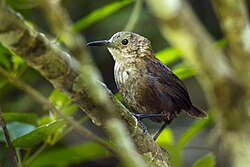| Hylorchilus | |
|---|---|
 | |
| Nava's wren (Hylorchilus navai) | |
| Scientific classification | |
| Domain: | Eukaryota |
| Kingdom: | Animalia |
| Phylum: | Chordata |
| Class: | Aves |
| Order: | Passeriformes |
| Family: | Troglodytidae |
| Genus: | Hylorchilus Nelson, 1897 |
| Type species | |
| Catherpes sumichrasti [1] Lawrence, 1871 | |
Hylorchilus is a genus of bird in the family Troglodytidae. It contains the following species: [2]
- Nava's wren (Hylorchilus navai)
- Sumichrast's wren (Hylorchilus sumichrasti)